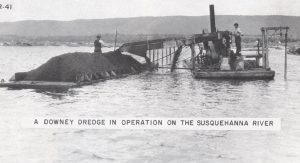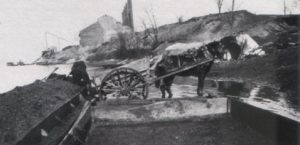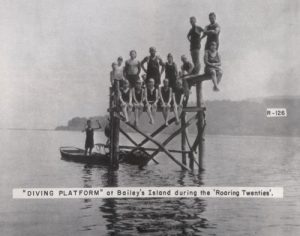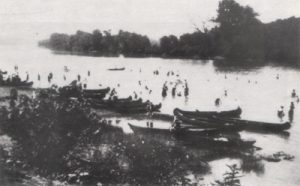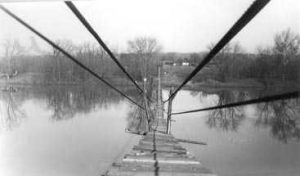
Walking Bridge to Bailey’s Island. Photograph from John Yetter Collection,
with permission from the Penn Cultural Center.
The Susquehanna River, which borders Steelton from the West, has been an important part of the town’s history. In fact, it was one of the main reasons the Pennsylvania Steel Company chose to build there. From its aesthetics to its multiple uses, the Susquehanna River has helped keep Steelton alive. While the steel mill has used it for transportation of materials, the residents used it for recreation, such as picnics and swimming, and for money, by boat rentals and coal dredging. The beautiful shorelines and sparkling water has also served as an excellent view for the busy steelworkers and traveling visitors.
Coal Dredging
- Sucking the coal dirt that is caught in the screens. Photograph from Stop, Look, Listen: Steelton, Pennsylvania.
- Loading the coal dirt onto cart. Photograph from Stop, Look, Listen: Steelton, Pennsylvania
Since 1900, before the mined coal was able to be used in the steel mill, tit had to be broken into smaller pieces and cleaned. Large amounts of coal dirt eventually drained into the creeks and the Susquehanna River. Some people were able to make a living by collecting this coal dirt from the bottom of the river and selling it. They used a pump system, using “suckers,” as described by Steelton historian Harold Kerns:
“The pumps were on a separate barge. The steamboat would take this pump and they had two flats with them, sometimes three, and they would drift down and start to pump. The scoop would drag along the bottom of the river and suck up the dirt. They had a screen coming across, and the coal dirt went across the screen. They had one screen that gave them the coal and the other that gave them the bar sand, the bar sand is what they make concrete with…They would pump the coal and then the steam boat would come over at the end of the day and take these flats full of coal and take them up to their property up in South Harrisburg and unload them there. And they sold that. They had 250,000 tons of coal a year that they dredged down at the river.”
Frank Albert added the description of the dredge workers at the end of the day:
“I had cousins, they used to help the downies and they would be dirt black. They wouldn’t have a shirt on and they’d be out there eight, nine, ten, eleven hours, sometimes twelve hours, at late at night. They would be so dark.”
Both men later clarified that the workers were not doing this to help improve the water quality, but only for the money. The 250,000 tons of coal dirt per year that they collected was enough to distribute to several places. The Pumping Station located on the edge of the West Side used some of the dirt to heat the entire building. A larger amount was transported to Texas by train to be used at another steel facility.
~~~~~~~~~~~~~~
A few years ago, the Rockville Bridge collapsed, dumping a half dozen coal train cars into the Susquehanna River. Many residents and environmental activists became concerned about the water quality of the river. A few “old-timers” knew that it was nothing compared to the large amount of coal dirt that had previously been on the bottom. Harold Kerns shared his comparison of the recent situation to that of the older bottom dirt in a recent interview:
“They made a big fuss about they safety, about the environmental, about how all this coal could damage the river, and this was nothing compared to when they took 250,000 tons of coal dirt out of there a year.”
~~~~~~~~~~~~~~
Recreation
- Swimmers taking a break on a diving platform. Photograph from Stop, Look, Listen: Steelton, Pennsylvania.
- A beach in Steelton. Photograph from Stop, Look, Listen: Steelton, Pennsylvania.
The river has been used for many recreational purposes over the years. From 1886 to the 1930s, a Steelton Ferry took visitors and residents around the River, averaging about a dozen trips a day. It also used to haul wagons so that customers could attend the Steelton Market.
A few of the islands, especially Bailey’s Island and White Island, were used for church picnics, fishing, swimming, and boating. Several steamboats and boat rentals took people to the islands. Frank Albert and Harold Kerns remembered the boat rentals and islands in one interview:
FA: That was the way they used to go over. Now, there was another fellow’s name, Willard Shrauder. He ran a boat place and he had what they call big batties…Anyway, he had two big boats they were called the batties, but he also rented canoes. And at one time, the beaches were sandy, just like you see at the beaches at the shore… He would charge you a nickel to take you over on a big battie [which could hold] fourteen people.
HK: They had canoes. Pop said, at one time, they had forty boats that he rented.
FA: Oh yea, he had a lot of boats. On the other side, the railroad owned it. He had buildings and his canoes were on
racks… Not only that, he put a dance pavilion over there on the island. And he made homemade root beer and stuff and sold it to them too! Now this was when things were tough, man! For a one-armed man, he was a hard worker!
